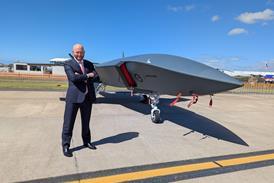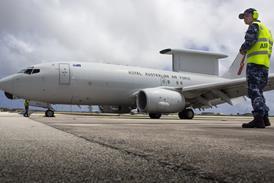US start-up XTI Aerospace is making moves intended to boost development of its conceptual TriFan 600, a fixed-wing vertical take-off and landing (VTOL) aircraft that will burn jet fuel.
Englewood, Colorado-based XTI disclosed on 12 June that subsidiary XTI Aircraft submitted a patent application with the US Patent and Trade Office for “innovations related to the TriFan 600”. In February, the company secured a new utility patent from the China National Intellectual Property Administration.
”The new patent applications and the previously-granted China patent relate to various technical or functional aspects of the TriFan 600, including the pivoting ducted fans that rotate between vertical lift and horizontal thrust, which, in turn, are designed to enable the TriFan 600 to efficiently transition from vertical take-off to forward cruise,” XTI says.

Chief executive Scott Pomeroy says the patents will protect XTI’s intellectual property and differentiate its product in a crowded field of eVTOL makers, most of which are relying on battery-powered or hybrid-electric propulsion systems.
XTI is targeting missions that require longer ranges and greater speeds than battery and hybrid-power technologies can currently provide. The TriFan 600 will have an estimated payload capacity of 1,090kg (2,406lb), airspeed of 300kt (556km/h) and a range of about 608nm (1,126km) when taking off and landing vertically, with added range when the aircraft uses runways. It is designed to seat six passengers and one pilot.
“We believe the TriFan 600 airplane will revolutionise point-to-point air travel by combining the comfort, speed and range of similar-size conventional business aircraft with the flexibility, convenience and pinpoint transportation achievable only with a vertical take-off and landing aircraft,” Pomeroy says. “We are targeting business, commuter and regional airline markets, as well as charter, other private air services and medevac operators.”
XTI Aerospace was listed on the US stock exchange on 13 March, following a combination of XTI Aircraft Company and Inpixon.
In connection to that deal’s closure, US regional airline company Mesa Air Group received 283,734 shares of XTI Aerospace common stock. The parent of Phoenix-based Mesa Airlines had previously entered a subjective purchase agreement for 100 TriFan 600 aircraft.
”Mesa’s obligations under the aircraft purchase agreement are subject to customary conditions for transactions of this nature, including FAA certification of the aircraft and future agreement between the parties on a number of terms and conditions, which may or may not be met,” Mesa said on 5 June.
Mesa holds warrants to purchase another 189,156 shares of XTI stock, which are subject to vesting milestones.
Mesa CEO Jonathan Ornstein views the TriFan 600 as a potentially unique solution for operating “Essential Air Service” routes, which are US-government-subsidised routes to smaller communities.
“Passengers in urban environments and smaller or rural communities across the United States that Mesa had served historically have been relatively disadvantaged by larger jets, which need substantial infrastructure and obligate passengers to find last-several-miles’ transportation, and by other expensive options like helicopters, which are limited by the distances, speeds and altitudes that they can fly,” he says.
”XTI Aerospace is working on not just a future solution, but one that is expected to be more efficient than existing business jet or [VTOL] alternatives,” he adds.
On 4 June, XTI disclosed a tentative deal with Texas-based manufacturer AVX Aircraft Company to accelerate the development, design and certification of the TriFan 600.
Under the letter of intent, AVX would become the prime contractor on the TriFan 600 development programme, providing ”detailed design, programme management, subcontract management and certification support services”.
XTI has recently been hovering a two-thirds-scale demonstrator aircraft during flight testing, with an eye on building a full-scale prototype in coming months.































